The Curious Acoustic Behavior of Estuarine Snapping Shrimp: Temporal Patterns of Snapping Shrimp Sound in Sub-Tidal Oyster Reef Habitat
- PMID: 26761645
- PMCID: PMC4711987
- DOI: 10.1371/journal.pone.0143691
The Curious Acoustic Behavior of Estuarine Snapping Shrimp: Temporal Patterns of Snapping Shrimp Sound in Sub-Tidal Oyster Reef Habitat
Abstract
Ocean soundscapes convey important sensory information to marine life. Like many mid-to-low latitude coastal areas worldwide, the high-frequency (>1.5 kHz) soundscape of oyster reef habitat within the West Bay Marine Reserve (36°N, 76°W) is dominated by the impulsive, short-duration signals generated by snapping shrimp. Between June 2011 and July 2012, a single hydrophone deployed within West Bay was programmed to record 60 or 30 seconds of acoustic data every 15 or 30 minutes. Envelope correlation and amplitude information were then used to count shrimp snaps within these recordings. The observed snap rates vary from 1500-2000 snaps per minute during summer to <100 snaps per minute during winter. Sound pressure levels are positively correlated with snap rate (r = 0.71-0.92) and vary seasonally by ~15 decibels in the 1.5-20 kHz range. Snap rates are positively correlated with water temperatures (r = 0.81-0.93), as well as potentially influenced by climate-driven changes in water quality. Light availability modulates snap rate on diurnal time scales, with most days exhibiting a significant preference for either nighttime or daytime snapping, and many showing additional crepuscular increases. During mid-summer, the number of snaps occurring at night is 5-10% more than predicted by a random model; however, this pattern is reversed between August and April, with an excess of up to 25% more snaps recorded during the day in the mid-winter. Diurnal variability in sound pressure levels is largest in the mid-winter, when the overall rate of snapping is at its lowest, and the percentage difference between daytime and nighttime activity is at its highest. This work highlights our lack of knowledge regarding the ecology and acoustic behavior of one of the most dominant soniforous invertebrate species in coastal systems. It also underscores the necessity of long-duration, high-temporal-resolution sampling in efforts to understand the bioacoustics of animal behaviors and associated changes within the marine soundscape.
Conflict of interest statement
Figures


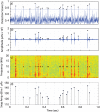


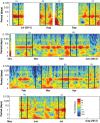
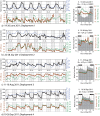
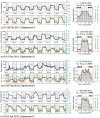


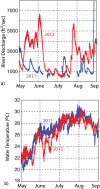
Similar articles
-
Silent oceans: ocean acidification impoverishes natural soundscapes by altering sound production of the world's noisiest marine invertebrate.Proc Biol Sci. 2016 Mar 16;283(1826):20153046. doi: 10.1098/rspb.2015.3046. Proc Biol Sci. 2016. PMID: 26984624 Free PMC article.
-
Hurricane impacts on a coral reef soundscape.PLoS One. 2021 Feb 24;16(2):e0244599. doi: 10.1371/journal.pone.0244599. eCollection 2021. PLoS One. 2021. PMID: 33626054 Free PMC article.
-
What's all that racket! Soundscapes, phenology, and biodiversity in estuaries.PLoS One. 2020 Sep 3;15(9):e0236874. doi: 10.1371/journal.pone.0236874. eCollection 2020. PLoS One. 2020. PMID: 32881856 Free PMC article.
-
Soundscapes and Larval Settlement: Characterizing the Stimulus from a Larval Perspective.Adv Exp Med Biol. 2016;875:637-45. doi: 10.1007/978-1-4939-2981-8_77. Adv Exp Med Biol. 2016. PMID: 26611014 Review.
-
Kenya.Mar Pollut Bull. 2001 Dec;42(12):1264-78. doi: 10.1016/s0025-326x(01)00241-7. Mar Pollut Bull. 2001. PMID: 11827110 Review.
Cited by
-
Sensing ecosystem dynamics via audio source separation: A case study of marine soundscapes off northeastern Taiwan.PLoS Comput Biol. 2021 Feb 18;17(2):e1008698. doi: 10.1371/journal.pcbi.1008698. eCollection 2021 Feb. PLoS Comput Biol. 2021. PMID: 33600436 Free PMC article.
-
Temporal patterns in the soundscape of the shallow waters of a Mediterranean marine protected area.Sci Rep. 2016 Sep 28;6:34230. doi: 10.1038/srep34230. Sci Rep. 2016. PMID: 27677956 Free PMC article.
-
Deep-Learning-Based detection of recreational vessels in an estuarine soundscape in the May River, South Carolina, USA.PLoS One. 2024 Jul 8;19(7):e0302497. doi: 10.1371/journal.pone.0302497. eCollection 2024. PLoS One. 2024. PMID: 38976700 Free PMC article.
-
Automatic Monitoring of Relevant Behaviors for Crustacean Production in Aquaculture: A Review.Animals (Basel). 2021 Sep 16;11(9):2709. doi: 10.3390/ani11092709. Animals (Basel). 2021. PMID: 34573675 Free PMC article. Review.
-
Long-term and large-scale spatiotemporal patterns of soundscape in a tropical habitat of the Indo-Pacific humpback dolphin (Sousa chinensis).PLoS One. 2020 Aug 12;15(8):e0236938. doi: 10.1371/journal.pone.0236938. eCollection 2020. PLoS One. 2020. PMID: 32785235 Free PMC article.
References
-
- Bormpoudakis D, Sueur J, Pantis JD. Spatial heterogeneity of ambient sound at the habitat type level: ecological implications and applications. Landscape Ecol. 2013;28: 495–506. 10.1007/s10980-013-9849-1 - DOI
-
- Luczkovich JJ, Daniel HJ III, Hutchinson M, Jenkins T, Johnson SE, Pullinger RC, et al. Sounds of sex and death in the sea: Bottlenose Dolphin whistles suppress mating choruses of Silver Perch. Bioacoustics. 2000;10: 323–334. 10.1080/09524622.2000.9753441 - DOI
-
- Cato DH, Noad M, McCauley RD. Passive acoustics as a key to the study of marine animals Sounds in the sea: From ocean acoustics to acoustical oceanography. Cambridge MA; 2005. pp. 411–429.
Publication types
MeSH terms
LinkOut - more resources
Full Text Sources
Other Literature Sources
Miscellaneous

